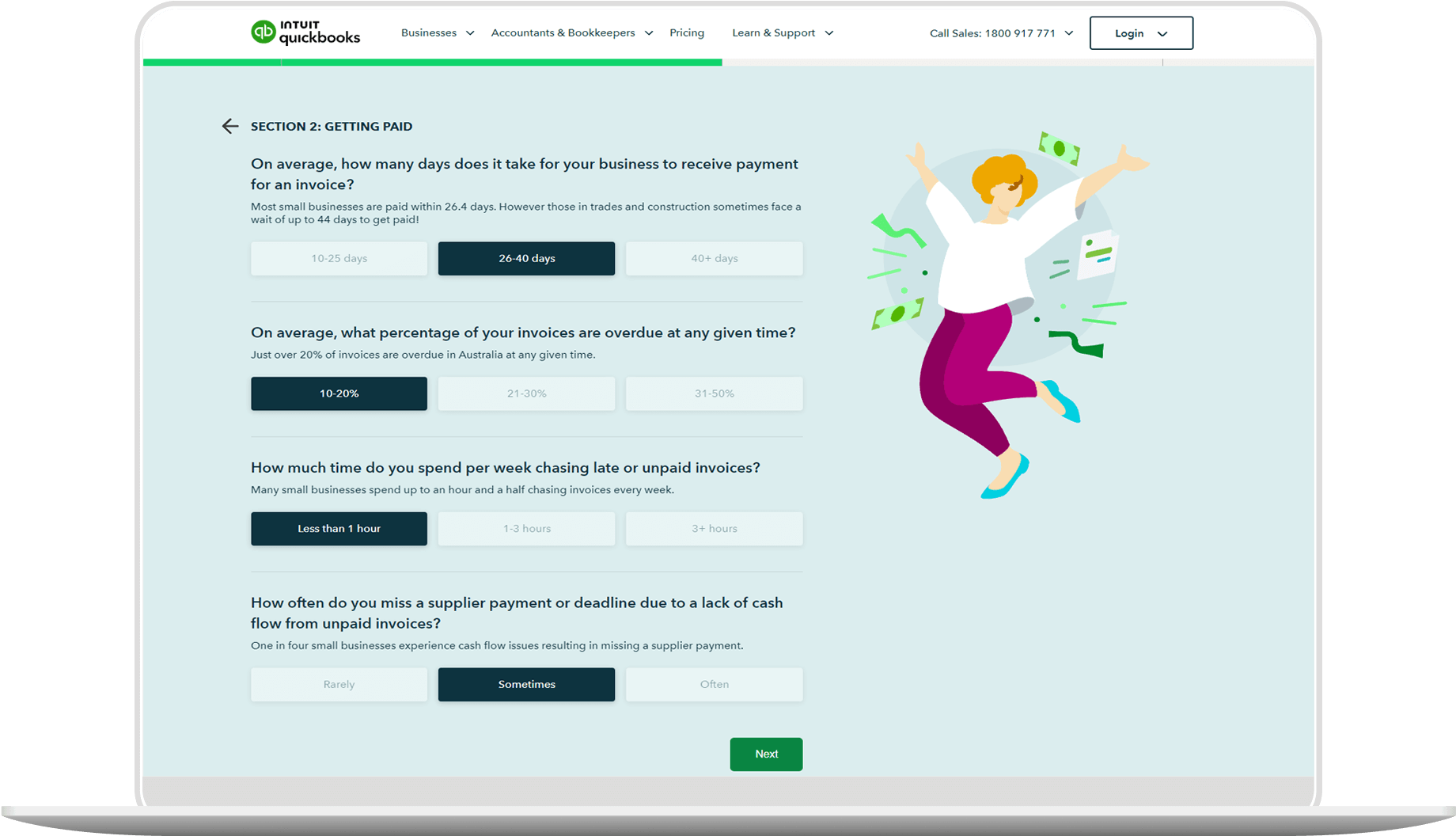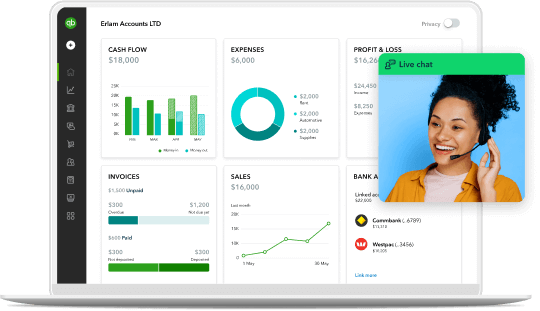Calculating taxes is one of the not-so-glamorous aspects of starting a business. You have to determine how to calculate taxes and how much tax to withhold. Then you have to crunch the numbers and prepare your cash flow plan. It can be far from relaxing at times!

FY25-26 monthly tax tables: Your guide to tax withholding and tax brackets
Fortunately for small business owners in Australia, the Australian Taxation Office (ATO) has made calculating taxes for employees simple with their readable tax tables. The monthly tax tables provided by the ATO help reduce the likelihood of making a common tax mistake. And, did we mention they’re free?
But if looking up tax tables is not your thing, using an accounting software like QuickBooks Payroll powered by Employment Hero can automatically calculate this with you. QuickBooks is up to date with tax rates and fully compliant with ATO requirements and most importantly, makes payroll a breeze.
In this article you will learn:
- Monthly Tax Table
- How to use the monthly tax table
- Example of a calculation using the ATO’s monthly tax table
- What is PAYG?
- What Are Your PAYG Obligations As An Employer?
- Employer Checklist For PAYG Tax Withholding
- ATO Tax Tables
- Important issues to note when using ATO tax tables
- Single Touch Payroll
- How Taxes Get Less Taxing
Monthly Tax Table
If you pay your staff on a monthly basis, the ATO provides a tax table that sets out how much pay withholding you need to send to the ATO. To make better use of their offerings and more clearly understand taxes in general, it’s important to fully grasp monthly tax tables, as well as other taxation methods and schedules. So, let’s take a closer look.
If you pay salaries on a monthly basis, feel free to use the ATO’s monthly tax table.
How to use the monthly tax table
The ATO monthly tax table document is organised into three columns. One column is dedicated to monthly earnings, the other two columns are dedicated to the ‘amount to be withheld’. These two ‘amount to be withheld’ columns give a different amount depending on whether an employee claims the tax-free threshold or not.
Sample of the monthly tax table:
Monthly earnings |
Amount to be withheld |
|
|
With tax-free threshold |
No tax-free threshold |
|
|
$520.00 |
$0.00 |
$82.00 |
|
$1,499.33 |
$0.00 |
$286.00 |
|
$2,366.00 |
$147.00 |
$468.00 |
|
$3,003.00 |
$290.00 |
$676.00 |
|
$4,784.00 |
$767.00 |
$1,248.00 |
|
$5,798.00 |
$1,092.00 |
$1,573.00 |
|
$6,656.00 |
$1,365.00 |
$1,846.00 |
|
$7,800.00 |
$1,733.00 |
$2,214.00 |
|
$8,970.00 |
$2,106.00 |
$2,587.00 |
The table can be used with these steps:
- Calculate your employee’s total monthly earnings – add any allowances and irregular payments that are to be included in this week’s pay to the normal monthly earnings, ignoring any cents.
- Find this amount in the column on the left ‘Monthly Earnings’
- The amount to withhold is in the second column, ‘With tax-free threshold’ unless your employee is not claiming the tax threshold.
You can view the full ATO monthly tax table guide for guidance on the amount that needs to be withheld.
Example of a calculation using the ATO’s monthly tax table
Your employee earns $1,885 monthly.
Looking at the middle column of the tax table, it shows that the monthly PAYG withholding to withhold for that employee is $52 where the tax free threshold is claimed.
What is PAYG?
Pay as you go (PAYG), also known as pay as you earn (PAYE), is a system of withholding amounts from employee payments so they can meet their end-of-year tax liabilities.
You have to register with the ATO for PAYG and withhold amounts monthly on your employees’ behalf. These amounts are used to pay the employee’s income tax at the end of the financial year.
Even though the employer has withheld tax, the employee may still be required to submit their individual tax return as this will take into account their other taxable income and deductions such as bank interest and union fees.
The ATO specifies how much employers need to withhold in their PAYG withholding tax tables depending on the income tax rates. This withholding is called PAYG withholding. You may also need an additional form for PAYG superannuation income streams if you have employees setting aside money toward superannuation.
What Are Your PAYG Obligations As An Employer?
To start paying PAYG for your employees, you’ll first need to register with the ATO. You can do so on the online business portal through the ATO website or by speaking with your tax agent.
After you have calculated and paid the withheld amounts, you need to report these amounts on your activity statements. You may need to provide PAYG withholding summaries to all employees and lodge a PAYG withholding annual report with the ATO or if you are reporting under STP, you no longer need to provide PAYG withholding summaries.
Most commonly, you’ll need to withhold from:
- Employees
- Directors
- Workers you have a voluntary agreement with
- Contractors or businesses that don’t quote their ABN
If an employee leaves or retires, you will need to:
- Make any final, outstanding, PAYG withholding payments
- Complete an employee termination payment
- Send a payment summary to the employee
- Keep a record of the employee’s TFN declaration until the end of the next financial year
- Keep a record of the PAYG withholding
If you run into any unique cases, do not hesitate to contact the ATO or a financial advisor.
Employer Checklist For PAYG Tax Withholding
Taxes are an involved process, and the PAYG method is no different. To ensure you don’t miss anything important, here are the steps for the entire PAYG process:
- Register
- Add up your employee’s monthly income
- Use the corresponding ATO tax table to work out the tax withholding (column 2)
- Pay amounts
- Report amounts on your activity statements
- Provide a summary to your employees
- Lodge an annual withholding report
Using the ATO tax tables, working out PAYG withholding for your employees is simple. Make sure to check whether you need to use any other tables for your employees (for example, if you need to make a Medicare levy adjustment).
For more tips to help you with your taxes and the end-of-financial year view our ‘Transform 2022 - Tips to transform tax time’ webinar.
Just make sure to keep your records, use STP and a solution like QuickBooks Payroll powered by Employment Hero to simplify the whole process.
ATO Tax Tables
The ATO produces a range of tax tables to help you work out how much to withhold from payments to your employees or other payees. Recently, new tax tables have been created for study and training support loans that replace earlier HELP, TSL, SSL, and SFSS tables.
If you employ people who are on holiday in Australia, the tax table for working holiday makers applies.
In addition to the tax tables, the ATO also has an online tax withheld calculator that calculates the correct amount of tax to withhold. There is one calculator for employees and another for contractors. To use the calculators, you will need the information employees supply in their tax file declaration, a withholding declaration, and a Medicare levy variation declaration.
The most common ATO tax tables you will need as an employer are the weekly, fortnightly, or monthly tax tables that correspond with how often you make pay runs.
Important issues to note when using ATO tax tables
Please note that the monthly tables will also apply if you pay any of the following:
- Paid parental leave
- Directors’ fees
- Payments to labour-hire workers
- Payments to religious practitioners
- Payments to government education or training
- Compensation, sickness, accident payments, or other leave payments
- Payments to foreign residents
Pick the table that corresponds with how often you make these payments. Other tax tables may apply if you have made payments to shearers, workers in the horticultural industry, performing artists, casual employees and workers who are on a working holiday.
If your employee has an accumulated debt (e.g HELP, SSL, TSL), you’ll need to use HELP, SSL, or TSL tax tables. If they are entitled to make an adjustment for the Medicare levy, you’ll also need to use adjustment tax tables.
If your employee is entitled to a tax offset, you’ll need to use the ATO’s ‘Ready reckoner for tax offsets‘ to convert their estimated annual entitlement to a monthly figure you can subtract from the withholding amount.
Single Touch Payroll
Single Touch Payroll (STP) is the most common way to pay employees and report payroll. STP Phase 2 was rolled out in Quickbooks Payroll powered by Employment Hero in January 2022. Under the STP system, employee wages, including PAYG are reported to the ATO every pay run as opposed to solely at the end of the financial year.
STP commenced on 1 July 2018 for employers with 20 or more employees and on 1 July 2019 for employers with under 20 employees. As of 1 July 2021 all employers were required to be reporting each pay period through STP.
You can easily comply with STP using the correct payroll software.
How Taxes Get Less Taxing
Taxes may not be your favourite thing in the world, but that doesn’t mean they have to be a difficult process. With a better understanding of the various tax methods, taxes can be just another item you check off your list during your monthly upkeep as a small business owner.
This will free you to focus on more pressing matters like growing your business, serving your customers, and enjoying the unparalleled freedom that comes with running your own company.
If you ever need help, don’t hesitate to contact the ATO, seek professional advice from a ProAdvisor or hire a professional accountant to do your taxes for you.
Disclaimer: This page is provided for general information purposes only and does not constitute accounting, tax, business, or legal advice. You should always consult your own advisors for advice relating to your business or situation. Always consult the ATO directly as information changes from time to time: https://www.ato.gov.au/rates/tax-tables/
Frequently asked questions
Find a plan that’s right for you
Free unlimited support
No contract, cancel anytime







